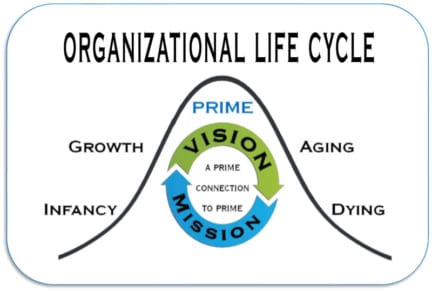 A fundamental truth for effective management of any organization is they, like living organisms, exhibit a life cycle with predictable behavior patterns as they grow and develop. Each phase of development in an organization comes with a unique set of challenges. How well or poorly management addresses these challenges, and productively transitions from one phase to another, significantly impacts the success of the organization. Leading an organization through transition is not easy, or obvious. The same methods producing success in one phase can create failure in another. Fundamental changes in leadership and management style are required to delicately balance the amount of control and flexibility needed for success in each phase. Leaders who fail to understand what is needed (and not needed) can inhibit the development of their organizations or plunge them into premature aging.
A fundamental truth for effective management of any organization is they, like living organisms, exhibit a life cycle with predictable behavior patterns as they grow and develop. Each phase of development in an organization comes with a unique set of challenges. How well or poorly management addresses these challenges, and productively transitions from one phase to another, significantly impacts the success of the organization. Leading an organization through transition is not easy, or obvious. The same methods producing success in one phase can create failure in another. Fundamental changes in leadership and management style are required to delicately balance the amount of control and flexibility needed for success in each phase. Leaders who fail to understand what is needed (and not needed) can inhibit the development of their organizations or plunge them into premature aging.
Organizational life spans can be as unpredictable as the weather, but it is somewhat predictable in phases of development. A human life cycles through different stages from birth to death, similarly organizations have a similar life cycle. Unlike the human life cycle, which moves through physical stages, the organization life cycle is not inevitable. This metaphor is used to demonstrate what will most likely occur without actions taken by effective leaders.
Leaders who understand this potential sequence of change are better positioned to help an organization avoid deterioration and decay. Describing typical stages and understanding how they develop helps leaders increase in confidence and effectiveness.
The organizational life cycle chart (shown below) graphically represents typical phases organizations experience over time. The left to right (x-axis) represents time and the bottom to top (y-axis) equals impact of the organization.











